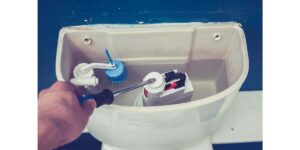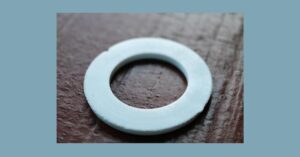A clogged toilet can be frustrating and stressful, especially when filled with toilet paper.
Not only can it cause inconvenience, but it can also lead to costly plumbing repairs if not handled properly.
Therefore, it’s essential to have a solution to unclog a toilet filled with toilet paper.
This article will provide a step-by-step guide on unclogging a toilet filled with toilet paper and tips on preventing future clogs and maintaining your toilet.
Following these tips can avoid plumbing emergencies and keep your bathroom functioning smoothly.
Common Causes of Toilet Clogs
Toilet clogs can happen to anyone, but some common causes can be easily avoided with extra care.
One of the most common causes of toilet clogs is excess toilet paper.
Using too much toilet paper or low-quality paper that doesn’t dissolve quickly can lead to a buildup in the pipes, causing clogs.
Foreign objects, such as toys or feminine hygiene products, should never be flushed down the toilet as they can cause clogs.
Improper waste disposal is another common cause of toilet clogs.
Flushing items that are not meant to be flushed, such as cotton swabs, dental floss, and baby wipes, can cause blockages in the pipes.
In addition, some people pour grease, oil, or fat down the drain, which can solidify and clog the pipes over time.
To avoid toilet clogs, it’s important to use toilet paper responsibly, dispose of waste properly, and never flush anything other than toilet paper and human waste down the toilet.
Tools and Materials Needed
Unclogging a toilet filled with paper requires some essential tools and materials.
Having the right tools on hand is important to avoid further damage to the plumbing system.
Here is a list of tools and materials needed for the job:
- Plunger: A plunger is a common tool used for unclogging toilets. It creates suction to help dislodge the clog and move it through the pipes. There are two types of plungers: the flange plunger and the cup plunger. The flange plunger is used for toilets, while the cup plunger is used for sinks and tubs.
- Plumbing Snake: A plumbing snake, also known as a drain auger, is a long flexible tool used to break up and remove tough clogs that a plunger can’t handle. It’s important to choose the right type of plumbing snake based on the size of the pipes and the type of clog.
- Enzyme Cleaner: Enzyme cleaners are natural and safe to use in toilets. They contain live bacteria that break down and dissolve organic matter, such as toilet paper and waste.
- Gloves: Gloves are important to wear during unclogging to protect your hands from bacteria and other contaminants.
- Bucket: A bucket can hold water and waste materials during unclogging.
- Towels: Towels can protect the floor and catch the water that spills during unclogging.
It’s important to have these tools and materials on hand before attempting to unclog a toilet filled with paper. They can be purchased at most hardware stores or online.
Step-by-Step Guide to Unclogging a Toilet Filled with Toilet Paper
Dealing with a clogged toilet can be daunting, especially if it is filled with toilet paper.
However, with the right tools and techniques, you can quickly and easily unclog your toilet without needing professional plumbing services.
Here is a step-by-step guide on how to unclog a toilet filled with toilet paper.
Locate the Clog in the Toilet Bowl
Before you begin, locating the clog in the toilet bowl is important.
Typically, you will notice that the water level in the toilet bowl is higher than usual or that the water is not draining properly.
If you suspect a clog, stopping flushing the toilet is best to avoid worsening the problem.
Using a Plunger to Clear the Clog
The most common tool for unclogging a toilet is a plunger.
To use a plunger, begin by filling the toilet bowl with enough water to cover the rubber part of the plunger.
Place the plunger over the clogged drain, push down firmly, then pull up quickly.
Repeat this process several times until the water starts to drain normally.
If the plunger does not work, you may need to try alternative methods, such as using a plumbing snake or a natural enzyme cleaner.
Alternative Methods for Unclogging a Toilet
If the plunger does not work, you can use a plumbing snake to clear the clog.
A plumbing snake is a long, flexible tool inserted into the toilet drain to dislodge the clog.
Insert the snake into the drain and turn the handle until the clog is cleared.
Another alternative method is to use a natural enzyme cleaner.
Enzyme cleaners are designed to break down toilet paper and other waste materials, making it easier to clear the clog.
Pour the cleaner into the toilet bowl and let it sit for a few hours before flushing.
Troubleshooting Tips for Common Issues
If you encounter any issues during the unclogging process, here are some troubleshooting tips:
- If the water level in the toilet bowl is too low, add more water to help create suction when using the plunger.
- If the plunger is not creating enough suction, try using a toilet auger to break up the clog.
- If the clog is particularly stubborn, you may need to use a combination of methods or seek professional plumbing services.
Emphasize Safety Precautions
When dealing with a clogged toilet, it’s essential to take safety precautions to avoid injury or damage to the plumbing system.
Always wear gloves to protect your hands and avoid using harsh chemicals that can damage the toilet or cause injury.
Proper Disposal of Waste Materials
After clearing the clog, it’s important to dispose of the waste materials to avoid future clogs properly.
Do not flush non-degradable materials such as wipes or sanitary products, as these can cause clogs in the plumbing system. Instead, dispose of these items in the trash.
Following these steps, you can easily and safely unclog a toilet filled with toilet paper.
If you are still experiencing issues, it may be best to seek professional plumbing services to avoid causing further damage to the plumbing system.
Product Reviews
This section will review various products to help you unclog a paper-filled toilet.
We will provide a brief overview of each product, along with their pros and cons, and give recommendations based on your needs.
Plungers
Plungers are the most common and effective tool for unclogging a toilet.
There are two types of plungers:
1. Cup plungers.
2. Flange plungers.
Cup plungers are best for sinks and flat surfaces, while flange plungers are best for toilets because they have an extra rubber flap that perfectly fits the toilet bowl.
Pros:
- Cheap and widely available.
- Easy to use.
- It can clear most clogs.
Cons:
- Requires physical effort.
- It can be messy.
Recommendation: The Korky Beehive Max Toilet Plunger has strong suction and fits well in most toilet bowls.
Plumbing Snakes
Plumbing snakes, or augers, are long, flexible tools to dislodge tough clogs.
They are especially useful for clogs too deep for plungers to reach.
Pros:
- Effective for tough clogs.
- It can reach deep into pipes.
- Reusable.
Cons:
- Requires some skill to use.
- It can damage pipes if not used properly.
Recommendation: The FlexiSnake Drain Millipede is easy to use and can reach 18 inches deep.
Enzyme Cleaners
Enzyme cleaners are natural, eco-friendly solutions that use enzymes to break down toilet paper and other waste materials.
They are safe for pipes and septic systems and can be used regularly to prevent future clogs.
Pros:
- Safe and eco-friendly.
- Effective at breaking down waste materials.
- It can be used regularly for maintenance.
Cons:
- It may take longer to work than other methods.
- It can be expensive.
Recommendation: The Green Gobbler Enzyme Cleaner is a powerful, fast-acting, safe solution for all pipes and septic systems.
Toilet Augers
Toilet augers are similar to plumbing snakes but specifically designed for unclogging toilets.
They have a long, flexible cable with a curved handle that makes it easier to maneuver in the tight spaces of a toilet bowl.
Pros:
- Specifically designed for toilets.
- It can clear tough clogs.
- Reusable.
Cons:
- Requires some skill to use.
- It can be messy.
Recommendation: We recommend the RIDGID Toilet Auger as it is easy to use and has a comfortable, ergonomic handle.
Preventing Future Toilet Clogs
Now that you know how to unclog a toilet filled with toilet paper, it’s important to take preventative measures to avoid future clogs.
Here are some tips on preventing future toilet clogs:
- Reduce the Amount of Toilet Paper Used: One of the most common causes of toilet clogs is using too much toilet paper. To avoid this, use only as much toilet paper as you need.
- Avoid Flushing Non-Degradable Materials: Flushing non-degradable materials down the toilet can cause clogs. This includes sanitary pads, tampons, baby wipes, and dental floss. Instead, dispose of these items in the trash.
- Install a Toilet Paper Holder: A toilet paper holder can help regulate the amount of toilet paper used and prevent excess from being flushed down the toilet.
- Perform Regular Toilet Maintenance: Regular toilet maintenance can prevent clogs from occurring. This includes cleaning the toilet bowl and ensuring that the water level in the tank is appropriate.
- Educate Your Family: Educate your family on proper toilet usage and disposal. Children may need extra guidance in this area, so teach them what can and cannot be flushed down the toilet.
Following these tips, you can significantly reduce the risk of future toilet clogs and avoid the need for frequent unclogging.
Conclusion
A clogged toilet filled with paper can be a frustrating and unpleasant experience.
With the right tools and techniques, you can easily unclog the toilet without causing damage to the plumbing.
It’s essential to take preventative measures to avoid future clogs, such as reducing the amount of toilet paper used and avoiding flushing non-degradable materials.
Always follow safety precautions, wear gloves, and avoid using harsh chemicals.
Following these tips, you can keep your toilet running smoothly and avoid costly repairs.
Don’t forget to leave your feedback and suggestions for future content topics in the comments section.




